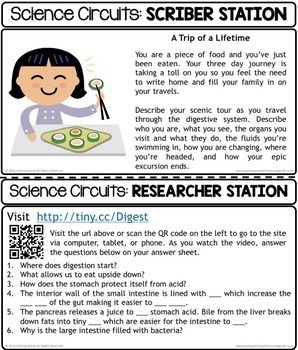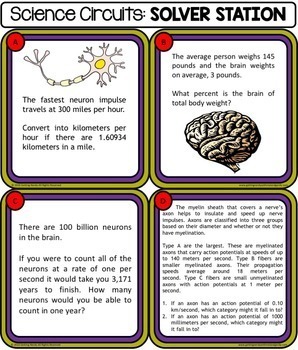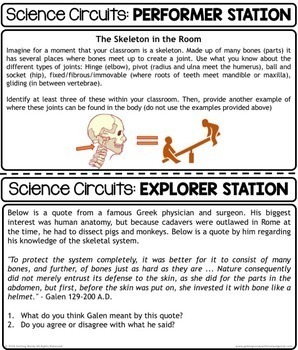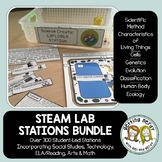Human Body Systems Bundle - STEAM Science Centers / Lab Stations
- Zip
What educators are saying
Products in this Bundle (7)
showing 1-5 of 7 products
Also included in
- Want to head full steam into S.T.E.A.M., but not sure how to get started? Try our twist on S.T.E.A.M.! With science as the primary background subject, students learn all about life science using Social Studies, Technology, ELA, Art, and Math. With over 280 stations, these student-led, print and go,Price $209.95Original Price $231.00Save $21.05
Description
With science as the primary background subject, students will learn about the human body systems by using Social Studies, Technology, ELA, Art, and Math. These student-led, print and go, low-to-no prep Science Circuit Stations are easy to implement with a few household items.
WHAT'S INCLUDED in this 1-2 DAY LESSON:
• Seven NON-EDITABLE station activities and one assessment with the following cross-curricular stations:
→ Explorer: Students learn about current scientific events, historical figures and global happenings
→ Researcher: Students use technology to research related topics
→ Maker: Students engage in engineering, designing, building, assembling, and/or experimenting
→ Scriber: Students write a response to a question or problem
→ Reader: Students answer questions related to a reading passage
→ Performer: Students use their creativity as they participate in one of the many arts
→ Solver: Students use their math skills to answer science related math problems
→ Scholar: Students complete a final assessment piece that aligns with the lessons in the circuit
• Directions for each activity
• Answer keys
• Station signs
• Student answer sheets, cover sheet and blank answer sheets for additional stations
STUDENTS WILL:
With some background knowledge, review and understand:
• Integumentary system
• Muscular system
• Skeletal system
• Respiratory system
• Circulatory and lymphatic systems
• Digestive system
• Reproductive and endocrine systems
• Urinary and excretory systems
• Nervous system
THIS PRODUCT IS ALSO FOUND IN OUR:
•Life Science Centers / Lab Stations Bundle - Cross-curricular STEAM Activities
CHECK OUT OUR OTHER HUMAN BODY PRODUCTS :
• Human Body Systems Complete Bundle - PowerPoint Unit, INB, Task Card, Word Wall
• Human Body Systems - PowerPoint & Handouts Bundle
• Human Body Systems - Interactive Notebook Activity Pack
• Human Body Systems - Word Wall
• Human Body Systems - Task Cards
• Integumentary system - Human Body "I Have . . . Who Has?" Game/Activity
SEE HOW THIS LESSON ALIGNS WITH THE NGSS, TEKS or GSE
Because we have created many of our own graphics or have purchased licenses to other graphics with permission, we cannot offer our resources in editable format unless otherwise stated.
TERMS OF USE (TOU):
All rights reserved by GETTING NERDY®️
• This product is to be used by the original purchaser only
• Intended for classroom and personal use only
• Copying for more than one teacher, classroom, department, school, or school system is prohibited
• This product may not be distributed or displayed digitally for public view
Failure to comply is a copyright infringement and a violation of the Digital Millennium Copyright Act (DMCA). Clipart and elements found in this PDF are copyrighted and cannot be extracted and used outside of this file without permission or license.
Human Body Bundle STEAM Science Stations © 2012 to present Getting Nerdy ®️ All Rights Reserved
www.gettingnerdyscience.com






